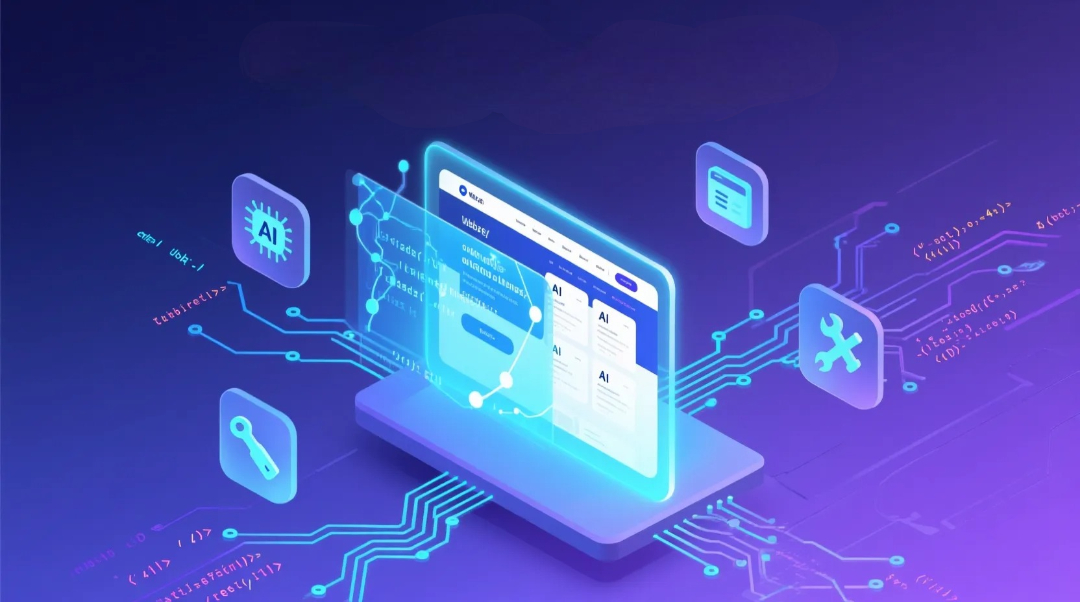
In this article, we will explore how AI can effectively assist you in your tech journey. Whether you are coding for projects or starting a tech business, AI can help you at every stage.
IN THIS ARTICLE
Introduction
How AI Powers Automation in Development
No-Code & Low-Code (Flat Coding) with AI
Designing Better UI/UX Using AI Tools
AI for Code Debugging, Fixing & Logic Improvement
AI assistant in code editors
Building your tech startup with AI
Enrich web-content using AI
My Suggestion for Beginners
Introduction
Web development has been one of the most in-demand skills in the world for decades. With it, you can not only write software but also showcase your ideas, projects, and skills to the world. While learning, you improve your problem-solving and logic-building abilities. You can help businesses grow online, support teachers in sharing study materials, or even build startups that make people’s daily work easier. The possibilities are endless—that’s why web development is such a powerful and popular skill today.
A few years ago, most of the work in this field was manual. Developers built websites from scratch, from designing the UI to writing the logic. It was a time-consuming process.
But things have changed with the rise of Artificial Intelligence. AI is transforming web development by automating many tasks and speeding up workflows.
Earlier, whenever we had a coding problem, we spent hours searching Google or forums like Stack Overflow. Even then, we often didn’t get the exact answer. Today, with AI tools like ChatGPT, you can get precise solutions in seconds—making learning and building much faster.
How AI Powers Automation in Development
When I use the word automation in this context, it means the answers you get from AI are not written by a human in real time. Instead, AI uses pre-trained algorithms called transformers that can understand your question and generate accurate answers in most cases.
Normally, if you ask a question, you’d search the internet, open multiple websites, and still might not find the exact answer. This takes a lot of time and effort.
If AI doesn’t already have the information, it can pull data from the internet, analyze it, and provide a short and clear response. This saves you from hours of searching.
That’s where tools like ChatGPT play a vital role. You get solutions tailored to your queries within seconds—fast, reliable, and without the usual struggle of long searches.
No-Code & Low-Code (Flat Coding) with AI
Flat coding is the idea of creating software code with simple commands. Today, there are many tools and AI-powered code editors that let you build applications even if you don’t have deep coding knowledge. This is especially useful for product engineers who want to create prototypes or sample products before the main development stage.
Here are some free and paid AI coding tools you can try:
1. ChatGPT / Grok / DeepSeek – Best for generating snippets or fixing logic (Free + Paid).
2. CursorAI – Full AI code editor.
3. Replit AI – AI coding editor.
4. PearAI – AI-powered code editor.
5. TraeAI – Advanced AI editor.
6. TrayAI – AI editor.
7. GitHub Copilot – AI pair programmer (50 free requests/month, then Paid).
Note: Most of the options above provide limited free access before switching to paid plans—except for option 1, which offers a much larger free service compared to the rest.
From my experience, if you’re serious about building a project and can pay a little, go with CursorAI or TraeAI—both gave me excellent results. GitHub Copilot is another good option. It’s affordable and you can unlock more features by upgrading.
Designing Better UI/UX Using AI Tools
A lot of people think AI can design a fully unique UI from scratch. But honestly—it can’t, at least not right now. AI has boundaries, and it sticks to the rules.
For example, if you ask GPT to design an About or Contact page with a “unique” layout, you’ll usually get something clean and simple, but not really original. That’s because AI doesn’t train on marketplace designs like Envato or ThemeForest (which are copyrighted). Instead, it learns from open resources and design principles. The result? Basic layouts that are good to start with, but not something that replaces a designer’s creativity.
At the end of the day, AI is a helper—it can save you time, but the real creative spark still comes from humans.
Now, here’s where AI actually shines: when you already have a UI mockup. If you give that to AI and ask it to generate code (HTML/CSS, React, or Tailwind), the results are surprisingly good. I’ve tried this many times, and not only does GPT create the structure, but it also makes it responsive.
After that, tweaking colors, adding effects, or improving the UX is easy to do manually. This way, you save hours of work and still end up with a design that feels polished and professional.
Honestly, the amount of time it saves is insane, you hit deadlines faster without compromising quality.
AI for Code Debugging, Fixing & Logic Improvement
AI has become really good at working with code. As developers, we often make small mistakes in our logic—even when the code technically runs. I’ve found AI to be super helpful in catching and improving those parts.
The process is simple:
1. Write your code or logic as you normally would.
2. Paste it into GPT (or another AI tool).
3. Ask for improvements.
Within seconds, it gives you a cleaner or more optimized version of the same code.
What I find even more interesting is how interactive AI has become. For example, it might suggest: “Do you want me to write a single-line version of your four-line code?” If you say yes, it immediately does it.
In many cases, AI also offers extra suggestions you might not have thought of—helping you refine your logic and get to a stronger final result.
AI Assistant in Code Editor
When writing software, we repeat a lot of the same tasks. To avoid that repetitive work, an AI assistant inside your code editor can be a real time-saver.
There are plenty of tools out there, but the one I personally use is Windsurf in VS Code. It gives inline code suggestions as you type, and with just a press of the Tab key, you can accept them instantly.
So how does it work? The AI observes your coding patterns. For example, if you write a function in one file and later try to create a similar function somewhere else, it recognizes the pattern and suggests the structure for you. All you need to do is tweak the parameters, and you’re done. This alone saves a huge amount of time in web development.
Another bonus is the built-in chat option. You can ask for bug fixes, improvements, or explanations without leaving VS Code. No need to switch tabs—everything happens right where you’re coding.
Windsurf gives the option for integrating paid model like GPT. So if you have any paid plans for GPT then you can easily integrated it into windSurf. After integration you can choose your model from options. Then your model will be use for response. I like this system because we get both paid and free options.
Note that windsurf is not like cursor editor. it just chat in vsCode where you get option for Ask only. So you can ask any related issues in chat only.
Building Your Tech Startup Using AI
This could easily be a full blog on its own, but let’s look at it briefly here—how AI can help you build a tech startup without the usual stress of finding a team in the early days.
If you’ve got a strong idea that solves a real market need but don’t have the budget to hire people right away, AI can be your first “partner.” You’ll be surprised how much it can do: acting as an information source, idea refiner, market researcher, advisor, and more.
In the beginning, instead of spending months looking for the “perfect team,” you can let AI handle a lot of the initial groundwork. Finding co-founders or reliable team members is tough—you never know how long someone will stay committed.
But if you give up on your idea just because of limited funds or lack of a team, you’re missing out. That’s where AI steps in. It’s like having an AI army backing you up, and most of these tools are free or very affordable.
Once you build a solid foundation and start generating revenue, then you can bring in real team members to scale things further.
Enrich Content Using AI
Your website’s content is the backbone of your business. If you fail to present it properly, you’ll quickly lose your audience’s attention. That’s why following some standard content patterns—such as clear headings, subheadings, and structured paragraphs—is crucial for SEO and readability.
The good news is that AI can help streamline this process. By simply defining your requirements—like where you want headings, what the tone should be, or what elements the page needs—you can get well-structured, optimized content in seconds.
Great websites don’t just present information; they engage users. Interactive elements like sliders, videos, maps, or dynamic content sections often perform better because they make the experience more lively and user-friendly.
Take an example:
AI Prompt for Image Sliders
Create an Image Slider with HTML and Tailwind, fully responsive for all devices. Apply a grayscale effect to all images.
This simple prompt will generate an image slider that meets your requirements. With just a few tweaks, you’ll have an optimized, ready-to-use component for your website.
But AI’s role goes beyond design. You can also use it to improve static content—like crafting better headlines, rewriting paragraphs for clarity, or even suggesting alternative layouts that make text more engaging and easier to scan.
In short, AI doesn’t just speed up your work; it helps you deliver content that’s readable, optimized, and appealing across all devices.
My Suggestion for Beginners
Don’t jump straight into AI coding without learning the basics. Build your foundation first:
Understand software development concepts.
Improve your logic-building skills.
Don’t just copy-paste AI code—analyze and learn from it.
Read documentation for better clarity.
Once you’re confident in the basics, AI can be a huge time-saver for things like UI development, bug fixing, and logic improvement. But remember: AI is not a replacement for your knowledge—it’s a tool to help you work smarter.
AI tools generate code based on patterns, and sometimes the results may not be perfect or maintainable. If you know how software works, you can guide AI to create cleaner and more reliable solutions in less time.
 LOADING...
LOADING...
